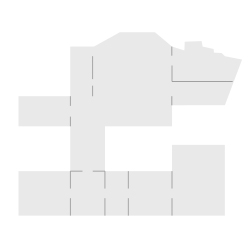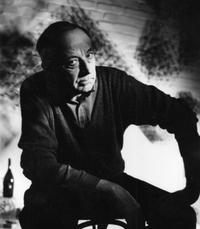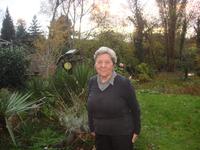Dialogue of Forces
For three years, the Elsi and František Kyncl Exhibitions Dialogue of Forces has been waiting for a “new life.” In the meantime Pavel Vašíček, who organized the exhibit in the Topič Salon, has passed away. It was with childlike astonishment that he observed these hanging spatial structures of Kyncl, as they quivered and rotated in the air (therefore, we photographed them for you from all angles). In the meantime, Elsi Kyncl’s eyesight became weaker, but the ability of her inner vision of the world and of her art in its special colorfulness and variety of forms down to the smallest detail remained just as strong as her mind: open and cheerful. Meanwhile, we also mark František Kyncl’s eightieth birthday, which he did not live to see.
Kyncl's subtle structures uncover the geometric power of the foundation and essence of the universe. František was not a mathematician. Mathematics “was in him” – in the same way that bees intuitively build their honeycombs, he glued together bamboo skewers with epoxy, and they grew elegantly like trees, both symmetrical and crooked, under the influence of the breath of the landscape. (Imagine his exhibition, for example, in a garden!) Alongside the living structures of František, Elsi exhibits her own cycle entitled Dance of Death or Totentanz. The black lines ripple right next to the white ones, which takes one’s breath away.
pb
Topičův salon
14. July - 15. August 2014
Curator: Petr Svoboda
Elsi - František Kyncl
Dialogue of Forces - Harmony of Energies
Elsi and František, two forces, two energies, a symbolic dialogue of the Earth and the Cosmos. The level-headed patient angel Elsi, who draws her energy and quiet strength from the depths of the archetypal Magna Mater memory, and the pilgrim František, an eternal explorer and traveller, churning out his inexhaustible energy in the search to touch at the core entity and original cause of subtle structures hidden in the parallel cosmological infinity of space-time and the very meaning of its order.
František, an exile, later sentenced in absentia by a Czechoslovak socialist court to an unconditional prison sentence, who logically does not return in 1968 from his official and legal study trip to Italy but departs from Austria and settles in Dusseldorf; a city spread out along the shores of the magnificent Rhine which by its character and landscape morphology most resembled his native environment of Pardubice, a place he never left in his heart of hearts.
Elsi, the beautiful angel, daughter of a famous Essen architect, who from her youth was surrounded by a rich cultural environment, soon gives up to everyone's surprise her own budding independent creative ways, and devotes all her strength and dedication to the significant Dusseldorf Mayer Gallery. There, with her proverbial care she creates the conditions to facilitate exhibitions of many up and coming artists who today belong to the context of world art; among them were Jean Tinguely, Joseph Beuys, Gerhardt Richter, Georg Baselitz, Norbert Kricke and Keith Flaring. The entire existing artwork of Elsi remained long hidden in the basement of the house where she lived together with František - although a chosen few were occasionally allowed a peek. Only thanks to the attentive eye and the far-sighted activity of Jan Placák, were Elsi's drawings exhibited in his gallery Ztichlá klika in Prague; that's when their inner strength and ability were revealed in their full force and beauty, and even after many years in hiding, managed again to reach out and grab the attention of a viewer's mind.
Once the pilgrim František settles in Dusseldorf, he searches for his own place – a creative space and facilities where he could continue his interrupted journey. He works hard for a merchant with rare carpets but then refuses a guaranteed career in this lucrative field and chooses the uncertainty of a free independent artist - as he enters the studio of Professor Gerhard Hoehma at the Dusseldorf Academy of Fine Arts. Before his departure into exile, the form and nature of his work touched mainly upon constructivism, as it was presented by the movement led by the prominent Czech theoretician Arsén Pohribný. This mutual co-operation continued even after František s departure to Germany because Pohribný was also forced to leave behind the promised oppressive dumpling of normalization offered by the Czechoslovak Socialist Republic - he settled abroad and lectured at the Universities of Basel and Milan.
Although František Kyncl´s work is based on the aesthetics of constructivism manifests to some extent, his inner character, insight and distinctive sarcasm safely protected him from slipping into the stance of an formal outside construction design play with a blind adoration of a technicist positivist faith. On the other hand, František's esprit and his aristocratic elegance along with his ability to sensitively penetrate beneath the surface of events and the perceptions stimulating his mind and surrounding his existence, continually drove him with unflagging energy and force to touch deeper and more intimately upon the hot marrow of the meaning of the Act of Birth and along with it the primary essence of the principle of cosmological order in the Universe.
Through his monostructures designed by nature on the metaphysical order of the Divine Trinity and treated in a clearly articulated rhythm inscribed into geometric shapes - the vertical, circle, cube, triangle, oval or diagonal - in the end the ultimate impact is that he creates his own peculiar symbolic language, expressing his intimate communication with the timeless eternal dimension of the space universe.
How František Kyncl perceived his creative journey, mission and his existence in the macrocosm and microcosm, is best described in his own written credo of 1994:
Why am I doing this as I do it, here's a little clarification
Probably since my boyhood, I felt a desire for some inner order and orientation which would make sense. Later I began to be attracted by some sort of intangible principles hidden behind the boundaries of the visible. WHY: light and darkness, heat and cold, the changing of the seasons, laughter and tears, the abundance of scents and smells, the sun, moon, stars, and what is behind those stars? Is there an end to the universe, or is „our universe“ part of another, and is that one even greater, and where then is the end of this universe... INFINITE...
Portrait, tree, landscape, doe, apple, rose - beautiful visible forms however they cannot exist without the „invisible structure“!
This time, my first and „most important“ discovery!
And then, like a full stop after one chapter:
POINT-LINE-TRIANGLE- -PYRAMID – visual elements, which I would like to use to express the regularities of natural structures and constructions.
I do not consider myself a painter or sculptor, I do not know who I am.
All I know is that I admire the structure of clouds and birds, the structure of snowflakes and raindrops, dawn and twilight, the construction of animals, passions of hope and sadness.
I admire and I bow before the structures of long ago and today, as well as the structures of the future - STRUCTURES OF INFINITY.
Düsseldorf, June 1994, F. Kyncl
The exhibition of František Kyncl in the Topič Salon in Prague is not biographical because it is not possible to present and fully encompass the whole range of the artist's work. Yet, it includes all the important clues that František left behind on his artistic journey and the spheres of interest which he touched upon and dealt with. Part of the exhibition is his phonetic recordings of sounds and scents created in the mid-twentieth century, which he transformed ten years later into the concept of phonetic paintings inspired by musical motifs. Also included, and for the author so important, are the spatial structures in the form of perforated monotypes, objects, reliefs and paintings; in which he endowed the newly discovered secrets pieced together into parallel universes in the form of a message which he implanted in us to arouse uneasiness in our minds and bring tension to the often banal earthly existence. The drawings of Elsi which were created decades ago, as well as those on which she began to work after the favorable responses to the exhibition in Ztichlá klika in Prague, start to become, through their clean lines, a metaphor, an abbreviation and a clear imprint of her always so clear and direct vision, in which she connects and combines the two bodies on paper, the human body with the body of the Earth.
The exhibition of Elsi and František Kyncl in the Topič Salon is actually their first joint presentation, a symbolic circle with an inscribed spiral, expressing dialogue between two forces, one external, expansively wandering and searching for the infinity of the universe, and a second force, an anchor, an inner one, based on the vitality and spirit of the great materia of Terra Mater. The dialogue with harmony, tenderness and the silent cry of both artists – and not only in their artistic expression or symbols – let this be for all of us a certain instruction and at the same time also a memento of our own ascent and stabilization. Just as the French poet Jean Arthur Rimbaud wrote in his poem Phrases:
„I stretched out ropes from spire to spire; garlands from window to window; golden chains from star to star, and I dance.“
Petr Svoboda
Exhibition plan
Audio
Files
- Fonetické struktury Františka Kyncla, Stephan von Wiese, 1998
- František Kyncl's Phonetic Structures, Stephan von Wiese, 1998
- Napjal jsem provazy zvonice od zvonice ..., Petr Svoboda, 2006
- I have pulled the ropes to the belfry ..., Petr Svoboda, 2006






